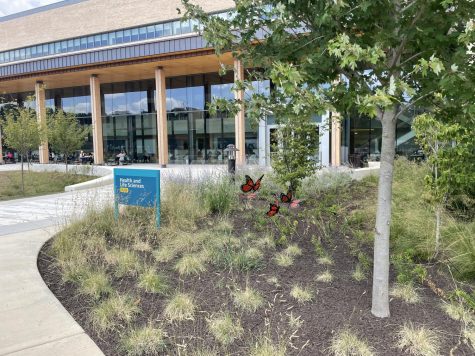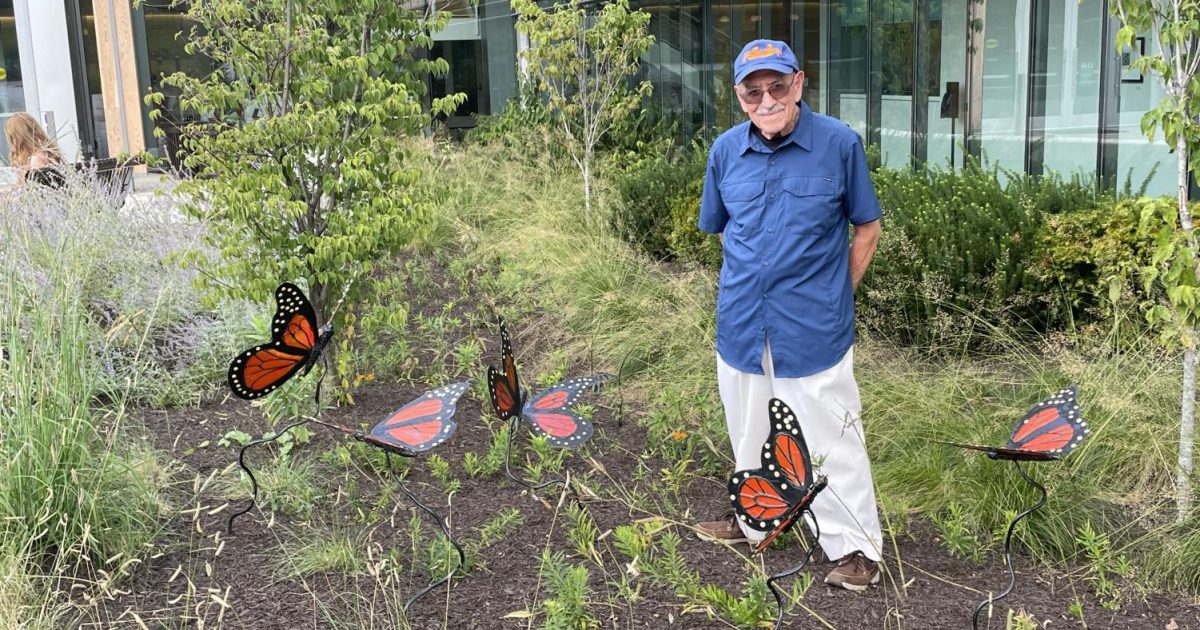Jenna Lagoey
Sculpture student Sergio Alvarez, a retired surgeon, stands in front of the Health and Life Sciences building with five statues he created for the new butterfly garden.
Last spring, students from several clubs and the biology department planted an on-campus garden designed to attract monarch butterflies.
The garden, outside the Health and Life Sciences Pavilion, is filled with milkweed, goldenrod, blueberries, zinnias and many other plants that attract monarch butterflies. An AACC student also designed and made five colorful butterfly statues for the garden.
“I am quite proud of the fact that we can say that we have literally planted hundreds of plants in this plantation [and] we also distributed several hundred more,” said Michael Norman, head of the AACC Environmental Center Laboratory.
The garden was a collaboration between the biology department, the Super Science Club, student ambassadors, the Sculpture Club, service-learning students, and volunteers.
“The beautiful thing about the project, not only did the college now have an outdoor sculpture installed, but also that there was an experience where students were learning by doing and also students were collaborating from different disciplines,” Wilfredo Valladares, director of the visual arts department and advisor to the Sculpture Club, said.
Bryant Pepe, a sophomore in physics and a member of the Super Science Club, said the garden is important because “monarch butterflies are struggling with endangered status. So we have to do everything in our power as environmentalists just to give them a fighting chance.
Students and campus volunteers planted hundreds of milkweeds near the Health and Life Sciences building.
“The important thing about milkweed…is that it’s the only plant that the monarch butterfly is able to complete its life cycle. [on] by laying its egg on this plant,” Norman said.
Milkweed is also the only food source for monarch caterpillars.

Sergio Alvarez, a retired surgeon taking AACC courses, built the butterfly statues, which he fashioned from welded metal and cast resin.
“I’ve always been fascinated by monarch butterflies,” Alvarez said, “which are very fragile, very small, and have the power to fly across the sky for thousands of miles.”
Norman said the goal of the biology department “is to maintain a healthy population of Asclepias [milkweed]not just around HLSB, but on campus in general.
“Wherever there have been really significant environmental successes, it’s always been when people work together for long periods of time, for extended periods of time,” Norman said, “and that’s what we’re looking for.”
Student Government Association President Abigail Billovitz-Hayes, Student Ambassador, helped plant the garden.
“Doing service projects like the Monarch Garden [are] definitely good for, you know, the campus and the community bringing everyone together,” Billovitz-Hayes said.

